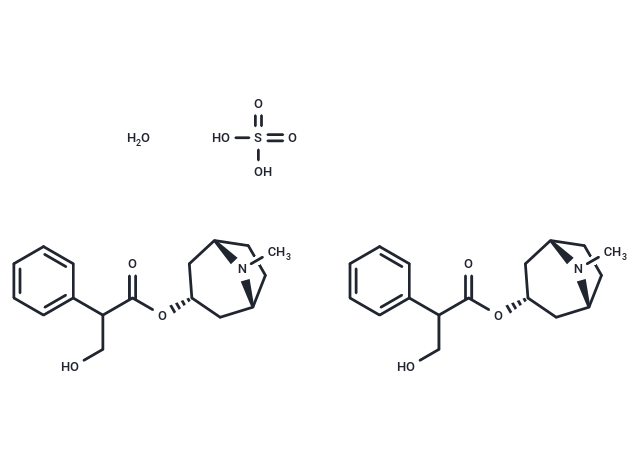Shopping Cart
Remove All Your shopping cart is currently empty
Your shopping cart is currently empty
Atropine sulfate monohydrate (Atropine sulfate hydrate), the sulfate salt of atropine, is a competitive muscarinic acetylcholine receptor antagonist.


| Description | Atropine sulfate monohydrate (Atropine sulfate hydrate), the sulfate salt of atropine, is a competitive muscarinic acetylcholine receptor antagonist. |
| Targets&IC50 | mAChR:2.5 nM |
| In vitro | Atropine increases the release of the neurotransmitter dopamine into the superfusate in vitro at 100-500 mM and into the vitreous in vivo at 250 mg. Atropine induces spreading depression (SD) in the in vitro preparation. Atropine reduces the ERG b- and d-wave, leads to damped oscillations of RPE potentials, and reverses the ERG c-wave. Atropine suppresses myopia only at doses at which severe nonspecific side effects are observed in the retina. [1] |
| In vivo | Atropine (1.0 mg/kg, i.p.), but not methylatropine (1.0 mg/kg, i.p.), prevents the enhancement of retention induced by both doses of the anticholinesterase when given immediately after training in mice. [2] Atropine administration effectively prevents bradycardia and second-degree heart block but induces pulsus alternans and hypertension in dogs. [3] Atropine has no effect on handling-induced acetylcholine output in the presence of 10 nM neostigmine, but causes greater and longer increases in the presence of 100 nM and 1000 nM neostigmine in rats. [4] Atropine not only blocks the rapid eye movement (REM) sleep increases induced by CGS but it also tends to decrease REM sleep compared to atropine preceding saline in rats. [5] Atropine decreases the time to exhaustion by 67% in intact rats and by 96.2% in adrenodemedullated (ADM) and also reduces the exercise-induced pituitary prolactin (PRL) release in both intact (50%) and ADM rats (90%). [6] |
| Synonyms | Atropine sulfate hydrate |
| Molecular Weight | 694.83 |
| Formula | C34H46N2O6·H2SO4·H2O |
| Cas No. | 5908-99-6 |
| Smiles | O.OS(=O)(=O)O.O=C(C(c1ccccc1)CO)O[C@H]1C[C@H]2CC[C@H](N2C)C1.O=C(C(c1ccccc1)CO)O[C@H]1C[C@H]2CC[C@H](N2C)C1 |
| Relative Density. | no data available |
| Storage | Powder: -20°C for 3 years | In solvent: -80°C for 1 year | Shipping with blue ice/Shipping at ambient temperature. | |||||||||||||||||||||||||||||||||||
| Solubility Information | DMSO: 128 mg/mL (184.22 mM), Sonication is recommended. Ethanol: 128 mg/mL (184.22 mM), Sonication is recommended. H2O: 127 mg/mL (182.78 mM), Sonication is recommended. | |||||||||||||||||||||||||||||||||||
| In Vivo Formulation | 10% DMSO+40% PEG300+5% Tween 80+45% Saline: 4 mg/mL (5.76 mM), Sonication is recommended. Please add the solvents sequentially, clarifying the solution as much as possible before adding the next one. Dissolve by heating and/or sonication if necessary. Working solution is recommended to be prepared and used immediately. The formulation provided above is for reference purposes only. In vivo formulations may vary and should be modified based on specific experimental conditions. | |||||||||||||||||||||||||||||||||||
Solution Preparation Table | ||||||||||||||||||||||||||||||||||||
H2O/DMSO/Ethanol
| ||||||||||||||||||||||||||||||||||||
| Size | Quantity | Unit Price | Amount | Operation |
|---|

Copyright © 2015-2025 TargetMol Chemicals Inc. All Rights Reserved.